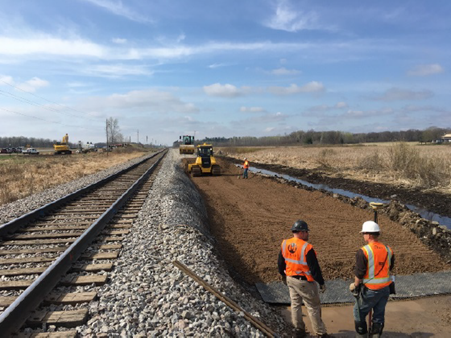
Project Summary/Scope: BNSF Railway constructed a second main line, adjacent to the existing line, near Little Falls, Minnesota. Due to site constraints, approximately 0.8 miles of this new line was constructed through a marsh area. There was limited access to this marsh area for geotechnical investigation, so site information was limited to test pits located at intervals of approximately 300 feet. Within a month of construction, a 300 foot section of the new line showed significant geotechnical distress. Horizontal and vertical movement was measured up to 0.11 feet and repair/remediation was deemed necessary.
In light of the limited subsurface information, new soil borings were drilled from track level and additional test pits were dug at 100 foot intervals. It was determined that the soil underlying the problematic 300 foot of new main line was comprised of a steep channel comprised of peat and soft, organic clays to a depth of up to 18 feet below the original stabilized subgrade. The final design required the line be built on a geosynthetic-reinforce load transfer platform. The 2.5 foot thick crushed granite LTP was constructed over helical piles and reinforced with multiple layers of a biaxial geogrid.

Complementary Technologies Used: Helical piles.
Alternate Technologies: Conventional piles were consider in lieu of helical piles, but were not considered a viable option due to anticipated issues with driving the piles through the previously stabilized subgrade.
Performance Monitoring: Movement of track post-construction was monitored, with no movement observed since end of construction.
Project Technical Paper: Mackiewicz, S., Race, M., Johnson, D. (2020) Expedited Repair of Railroad Track Subgrade Failure Using a Column Supported Geosynthetic Reinforced Load Transfer Platform, Geosynthetics 2020 – Case Histories, 8-10 March 2020, Charleston, SC.
Date Case History Prepared: 13 February 2022
Case History Prepared By: Melissa S. Beauregard
